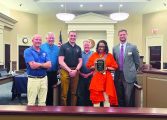By Page H. Gifford
Correspondent
Recently, three black bear cubs, each weighing less than two pounds, were admitted to the Wildlife Center of Virginia in Waynesboro after their den was destroyed at a construction site in Orange County. The cub’s mother fled during the incident, and one of the cubs was injured. Wildlife biologists decided that because of ongoing construction in the area, it was safer to transport the cubs to the center than to try reuniting the cubs with their mother.
On admission, the three bears were each assessed by the veterinary team. Each was then given a number and weight.
“They were the size of large potatoes,” said Outreach Supervisor Connor Gillespie. Two of the cubs were both active and healthy. The third cub, however, was much smaller and had a deep laceration on the top of his left hind leg. “The vet team bandaged the cub’s leg and are providing pain medication, but the prognosis is grave, the cub may have permanent damage to his leg,” said Gillespie.
Currently, all three cubs are receiving around-the-clock care in the Center’s ICU, with bottle feedings of special bear formula every six hours, even throughout the night.
“The first few days are crucial for orphaned cubs,” said Dr. Karra Pierce, Director of Veterinary Services. “We focus on providing warmth, fluids, and specialized formula, and emergency veterinary care to address their immediate needs. Once they’re stabilized, we can begin to collaborate with Department of Wildlife Resources biologists and determine the best long-term course of action.”
The Department of Virginia Wildlife Resources (DWR) was hoping to place the cubs with a mother bear in the wild that can foster them, but options appear to be limited this year.
“When looking for potential foster mothers, biologists need to assess the location of the female and den, the age of the female, the number of cubs she already has, and even the weather,” said DWR bear biologist Katie Martin. “This year, most of the bears that DWR tracks with GPS collars have not given birth to cubs, so finding a good foster option may prove difficult.”
If the cubs are not able to be fostered, they will stay at the Wildlife Center to be raised under the care of the rehabilitation team. The hope is that the cubs can eventually be released back into the wild once they are old enough and have the skills to survive on their own. The Center is looking at a release date of April 2025, 14 months from now.
You can visit the Center’s website — wildlifecenter.org — to read updates on the cubs and to see photos and videos of the cubs. The Center’s website also includes tips on how to live safely with bears as our neighbors, making sure that bears do not have access to trash and birdfeeders, for example, and giving space to bears if you encounter them. You may also donate to help support the care of these three cubs.




